Jazzahead 2023 Nachbetrachtung
Die Vorbehalte gegen deutschen Jazz sind bekannt: zu kopflastig, zu akademisch, zu hermetisch, zu technisch, zu schwer zu vermitteln. 18 Hochschulen hat das Land, es stehen den jährlich in Erscheinung tretenden Absolvent*innen schlicht zu wenig Spielstätten gegenüber, es ist das Publikum überaltert, zwar scheint der Generationenwechsel unter den Musiker*innen vollzogen, gleich auch wartet das junge Publikum auf seinen Einsatz und lässt sich lieber Playlists gefallen, das ist bekannt, es gelte auch, nichts zu beschönigen, allein, die Rituale bleiben die gleichen.
Conic Rose

Konstantin Döben (tpt, fgh) · Johannes Arzberger (p, elecs) · Franziska Aller
(b) · Bertram Burkert (g) · Nicholas Stampf (dr)
Jonas Engel

Jonas Engel (as) · Karlis Auzins (ts) · David Helm (db) · Dominik Mahnig (dr)
Lilja

Oddrun Lilja Jonsdottir (g, voc) · Sanne Rambags (voc) · Bafana Nhlapo
(voc, percs) · Jo Skaansar (voc, b) · Erik Nylander (dr)
Ana Carla Maza

Ana Carla Maza (clo, voc) · Norman Peplow (p) · Luis Guerra (percs) ·
Marc Ayza (dr)
2013 hieß es „Dies ist keine Messe, es ist ein Familientreffen“ – die „jazzahead!“ in Bremen, 2023 hieß es: „Jazzahead 2023 – eine Messe für ein Fachpublikum aber auch für ein breiteres Publikum des Jazz“
Ein Fachpublikum, dampfplaudernd über Geschmack, ästhetische Fragen und ob dies und das noch Jazz sei, schau, wie wenig Haare ich noch habe. Nach dem Konzert von Ana Carla Maza hieß es, das war sehr unterhaltsam, könne aber gleich auch auf jedem Kreuzfahrtschiff stattgefunden haben – ich drehe mich um und blicke in zwei von Vollbart und Base-Cap bedeckte Gesichter und denke für mich, sie passen auf jeden Kreuzfahrtdampfer, sie passen in jede Eckkneipe, sie könnten ebenso gut in den Rängen von Werder Bremen Platz finden.
Was ist Jazz – eine so heitere wie sinnfreie Frage, ein Fachpublikum bezieht seine Legitimation aus fachpublikumsspezifischen Fragen, das breite Publikum geht sich das anhören und ist begeistert.
Musiker*innen wurden gesichtet im Foyer des Hotels, in der Übertragung zum Deutschen Jazzpreis, beim Frühstücksbuffet am nächsten Morgen – und fuhren ab. Nicht mehr gesehen. Auf Wiedersehen, welches Wiedersehen?
Das Fachpublikum hat sich für die Halle 6 registrieren lassen und darin zurückgezogen, das breite Publikum macht sich Gedanken über die Fallhöhe des Jazz und seine Akrobaten und Dompteure, ein graumeliertes oder weiß schimmerndes Publikum betrachtet die Drahtseilakte und Fallstrickleitern der verschiedenen Bühnen und klatscht erleichtert, zurückhaltend oder auch etwas stürmischer bei überstandenem Vierfachsalto auf dem Klavier.
Familien stehen Schlange vor Halle vier und hören nicht etwa Jazz, sie geben ihre Stimme ab für Erdoğan oder Kılıçdaroğlu. Wir sind in Bremen – hinter dem Hauptbahnhof auf einem Messegelände – wo es mehr Parkplätze gibt als Automobile – wir müssen täglich durch den Bahnhof hindurch, wo die gestaute Wut den Leuten bis zum Hals steht. Wir können lesen, dass The German Culture Minister verkündet: Jazz is the Language of Freedom.
Wer Saxophon spielen kann oder Schlagzeug, ist nicht etwa gefangen im Quintenzirkel, sondern frei zu spielen, was er nicht zu denken wagt, der Unterschied zwischen Geige und Bratsche ist so erheblich wie der zwischen Trompete und Flügelhorn. Das Klavier kann man mit Ellenbogen spielen, ein Kontrabass oder Cello mit Plastiklöffeln.
Einige die dort auf der Bühne stehen verweisen auf die, die hinter der Technik stehen, gegessen wird, was aus dem Kiosk kommt, das Fachpersonal sitzt im Restaurant, das breite Publikum unter Bäumen auf dem Hof vor dem Kulturzentrum, das sich Schlachthof nennt.
Der grüne Pfeil ist so prägnant wie die Broschüre für die Clubnight unübersichtlich bleibt, wir geben 78 Euro aus für die Clubnight und erleben den Abgesang auf den Jazz bei Jason Miles und können vor Erbarmen nicht mal frieren. Wir setzen uns ans Ufer und bestaunen die Kanonenrohre der Admiral Nelson, als wären sie aus Pappe.
Das Ganze wird kräftig bezuschusst mit einem immer breiten Lächeln, obwohl sich dahinter die Erschöpfung Bahn bricht, weil vieles von dem, was man dem breiten Publikum anbietet, sich auch für das Fachpublikum anhört, als hätte es das schon häufiger gehört. Wenn zum Beispiel das Klavier genutzt wird wie ein Schlagzeug und es immer nur ums Rasseln, Klappern oder Klirren irgendwelcher Utensilien in den Saiten geht – und hier und da ein Vögelchen aufsteigt.
Gleich auch deine Englischkenntnisse sich erschöpfen in How are you, nice to meet you, thank you for coming and Bye bye, see you – what an amazing drummer kann man sagen zum Drummer von Jonas Engel und Athina Kontou, sein Name: Dominik Mahnig, er kommt aus Köln.
Amalia U Obrębowska
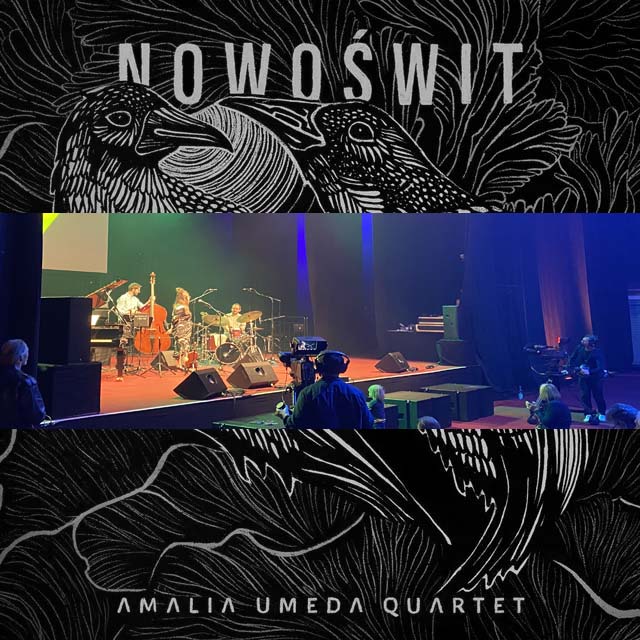
Amalia Umeda Obrębowska (vl) · Franciszek Raczkowski (p) ·
Michał Aftyka (db) · Michał Szeligowski (dr)
Wolfert Brederode
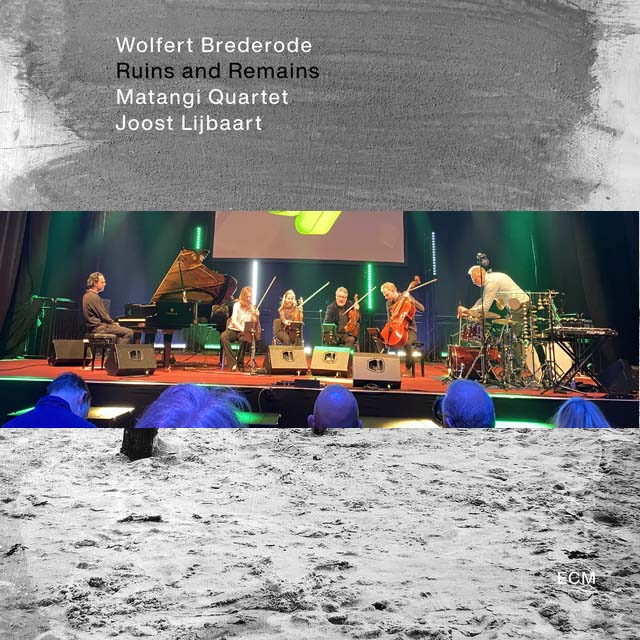
Wolfert Brederode (p) · Maria-Paula Majoor (vl) · Daniel Torrico Menacho (vl)
· Karsten Kleijer (va) · Arno van der Vuurst (clo) · Joost Lijbaart (dr)
Alex Koo

Alex Koo (p)
Olga Reznichenko

Olga Reznichenko (p) · Maximilian Stadtfeld (dr) · Lorenz Heigenhuber (db)
Wir aber sind in Bremen, Halle 7.1 oder Halle 7.2 oder Schlachthof – ein Campus mit Freejazz-Attitüde.
Als sie dann zu siebt oder acht gleichzeitig ins Horn blasen, ist das breite Publikum in Ekstase, offensichtlich wird: bejubelt wird, was man kennt. Auch wenn es nach Brötzmann klingt, gejubelt wird, weil es nach Brötzmann klingt. Und wenn da drei gegeneinander spielen, ist es recht. Und wenn sie im letzten Stück auf Popmusik machen, ist es auch recht.
Auf diesem Campus zwischen Köln und Berlin – sie schmusen sich einander in die Jazztreue, bis zum jüngsten Gesicht – da allen bewusst wird, dass jedes Leben eine Grenze hat – und die Besinnung auf das folgt, was essentiell sein könnte. Nicht den Tönen hinterherzujagen, die sich verflüchtigen, sondern den Tönen entgegenstreben, die in dir bleiben – weil sie aus dem Bauch sind, oder von Herzen kommen –
Der alternde Jason Miles allein im Dachgeschoss wie er von Miles Davis und Keith Jarrett erzählt und aber auch zeigt, wie sich kaum jemand mehr für ihn interessiert und er in Portugal von seiner New Yorker Zeit träumt – eine traurige Nummer – seine kleinen neugierigen Augen | sein Abgehängtsein
Jason Miles bringt es auf den Punkt: Musik muss das Herz berühren und in dir bleiben, du suchst nach einer unvergesslichen Melodie – dieses Suchen folgt bis auf die spielenden Finger – bis sie wie Miles Davis im Raum rumstehen und grunzen, dass von den 10.000 Dollar vom letzten Auftritt nichts mehr übrig ist.
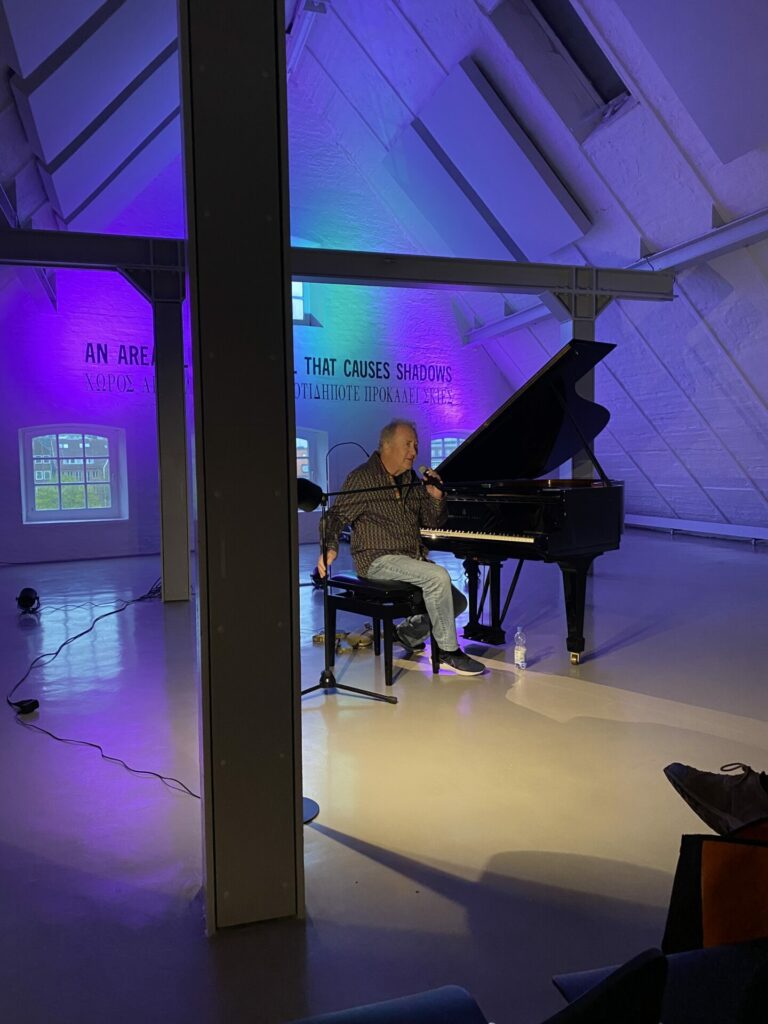
Jazzahead 2023 Nachbetrachtung – Jason Miles über Miles Davis
Das Fachpublikum unterscheidet sich vom breiten Publikum insofern, als es eine eigene Familie darstellt, in der die Mitgliedschaft dadurch geklärt ist, dass niemand es wagen würde, seine Stimme gegen Mutter zu erheben, deswegen es Bandnamen gibt wie Mother.
Oder war das gar nicht Familie sondern Campus ? – und so gar nicht Messe – die PROs sind die Profis, die sich in der Lounge zum Talk treffen und sich Visitenkarten austauschen – während wir als breites Publikum zum Fußvolk mutieren, die von Halle zu Halle zum Schlachthof wechseln und dort gleich mal richtig weggekeult werden.
Lucia Cadotsch

Lucia Cadotsch (voc) · Wanja Slavin (saxs, cl, fl, synths) · Heidi Bayer (tpt) ·
Florian Trübsbach (as, cl, fl) · Phillip Dornbusch (ts, cl, fl) · Shannon Barnett (tb) ·
Johannes Lauer (tb) · Mark Pringle (p) · Felix Henkelhausen (db) · Fabian Rösch (dr)
Athina Kontou
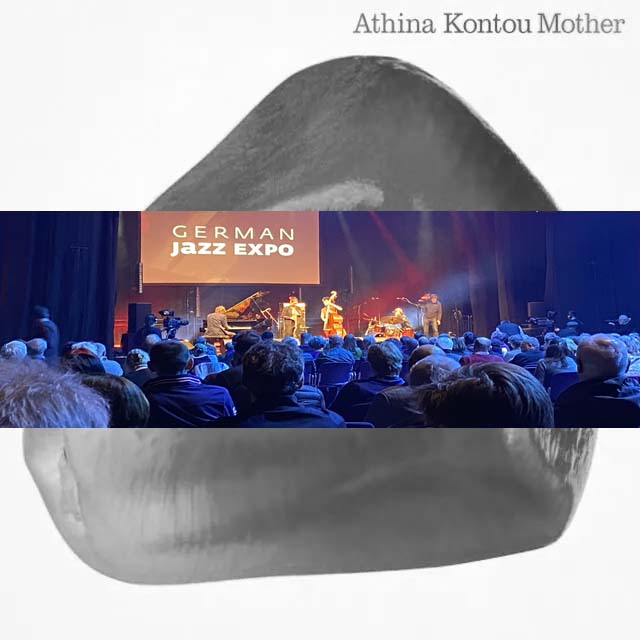
Athina Kontou (b) · Luise Volkmann (sax) · Lucas Leidinger (p) ·
Dominik Mahnig (dr)
Gina Schwarz
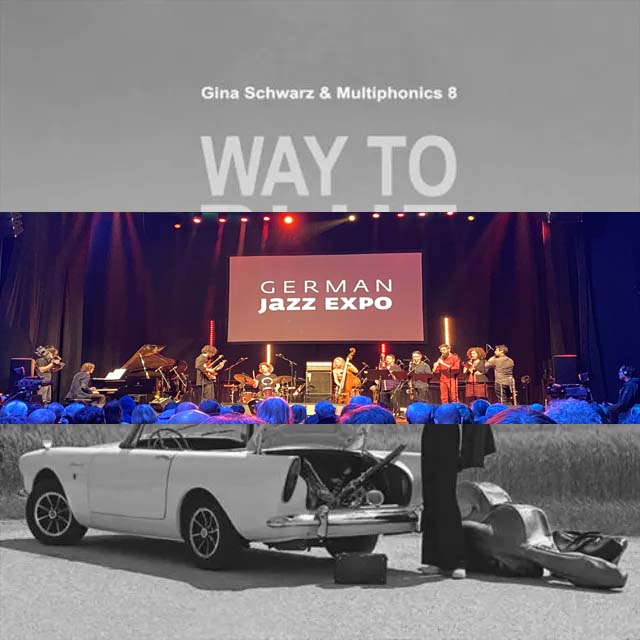
Gina Schwarz (comp, b) · Daniel Manrique-Smith (fl) · Annette Maye (Bb-cl) ·
Stephan Dickbauer (Bb-cl) · Steffen Schorn (contra-alto cl, c-melody sax) ·
Peter Joyce (b-cl) · Lucas Leidinger (p) · Mahan Mirarab (g) · Jens Düppe (dr)
UASSYN

Tapiwa Svosve (as, bells) · Silvan Jeger (db, bells) ·
Vincent Glanzmann (dr, bells)
Versuche zu sortieren – es gab sehr gute Musik – es gibt (noch) keine journalistische Aufarbeitung und keine Hinweise darauf, dass sich hier universitäre Räume zeigen, sie aber unter sich bleiben – alles in allem eine interessante Reise mit allerdings ernüchterndem Fazit, vielleicht auch mal gut so: Jazz Musicians können musizieren, sie können Musik – die ist weiterhin akademisch im Bereich der Hochseilartistik, es wird viel arrangiert, weniger komponiert, die Suche nach dem Ton, der dich im Herzen trifft, ist nicht ihrs – sie bleiben lieber außergewöhnlich und akrobatisch.
Das Publikum verjüngt sich nicht, auch wenn gern das Gegenteil behauptet wird.
Es waren junge Musiker u. Musikerinnen, die sich einem alternden Publikum zeigten – anzukommen ist nie leicht, und aufgenommen zu werden ebenfalls schwer, Bremen wirkte als Kulisse für einen schrägen Film – mit seltsamen Bildern von Leuten, die selbst in einem prekären Bereich lieber VIP oder PRO sind, als sich zu zeigen und zu sprechen.
Im Scherz ist da nichts zu sehen, betonen lässt sich nur, dass es nichts zu beschönigen gibt, für die Zukunft heißt es: den Jazz wieder kritischer zu sehen und ihn auch mehr im Stich zu lassen, denn hochzujazzen, was sich nur per Subvention über Wasser hält, sollte sich auch lohnen für die, die von all dem nichts mitbekommen oder verstehen, aber so lange es eine Veranstaltung bleibt, die sich nicht öffnet, sondern selbst erfüllt, sollte die offensichtliche Strukturkrise, in der sich der Jazz in Deutschland befindet, auch mal die Frage erlauben, wie man aus dem herausfindet, und wieder Musik macht, die sich vor einem Publikum legitimiert und nicht vor Amtsstuben.
Dieses Hochjubeln einer Musik, die in Deutschland akademisch, sperrig und brötzmannmäßig die immer wieder alten Dinge zeigt und somit wieder und wieder Konserven öffnet und spielt, sollte man der Ehrlichkeit halber gleich ins Museum bringen und es auf sich beruhen lassen? Oder ist etwa das Publikum Teil dieses Museumsinventars, das sich bei jeder Gelegenheit selbst feiert? Wir wissen aber auch: Publikum gewinnst du eher selten, wenn du es beschimpfst. Es bleibt einfach kompliziert.

Jazzahead Bremen 2023
Jazzahead 2023 Nachbetrachtung
jazz konzerte bremen 2023 * jazzahead 2023 tickets * musikfest bremen 2023 * jazzahead 2024 * weiteres Festival im Mai —
English Version
The reservations about German jazz are well known: too top-heavy, too academic, too hermetic, too technical, too difficult to communicate. The country has 18 universities, there are simply too few venues for the number of graduates who appear every year, the audience is outdated, the generation change among the musicians seems to be complete, but the young audience is waiting for their turn and prefers to put up with playlists, that is well known, and there is no need to gloss over anything, but the rituals remain the same.
In 2013 it was „This is not a fair, it’s a family reunion“ – the „jazzahead!“ in Bremen, in 2023 it was „Jazzahead 2023 – a fair for a professional audience but also a wider audience of jazz“.
A professional audience, steam chatting about taste, aesthetic questions and whether this and that is still jazz, look how little hair I have left. After Ana Carla Maza’s concert they said it was very entertaining, but it could have taken place on any cruise ship – I turn around and look into two faces covered by full beards and baseball caps and think to myself, they fit on any cruise liner, they fit in any corner pub, they could just as well find a place in the ranks of Werder Bremen.
What is jazz – a question as cheerful as it is meaningless, a specialist audience derives its legitimacy from specialist audience-specific questions, the general public goes to listen to it and is thrilled.
Musicians were spotted in the foyer of the hotel, during the broadcast of the German Jazz Award, at the breakfast buffet the next morning – and left. Not seen again. Goodbye, what goodbye?
The professional audience has registered for Hall 6 and retreated into it, the general public ponders the fall height of jazz and its acrobats and tamers, a grey-haired or white-shimmering audience watches the tightrope acts and trap ladders of the various stages and claps with relief, restraint or even a little more stormily at surviving quadruple somersaults on the piano.
Families queue up in front of hall four and don’t listen to jazz, they cast their votes for Erdoğan or Kılıçdaroğlu. We are in Bremen – behind the main station on a fairground – where there are more parking spaces than cars – we have to pass through the station every day, where the pent-up anger is up to people’s necks. We can read that The German Culture Minister proclaims: Jazz is the Language of freedom.
Those who can play the saxophone or the drums are not trapped in the circle of fifths, but free to play what they dare not think; the difference between the violin and the viola is as considerable as that between the trumpet and the flugelhorn. You can play the piano with elbows, a double bass or cello with plastic spoons.
Some of those standing there on stage refer to those standing behind the technology, people eat what comes out of the kiosk, the professional staff sits in the restaurant, the broad audience under trees in the courtyard in front of the cultural centre called the slaughterhouse.
The green arrow is as concise as the brochure for the club night remains confusing, we spend 78 euros for the club night and experience the swan song to jazz with Jason Miles and can’t even freeze with pity. We sit down on the shore and marvel at the gun barrels of the Admiral Nelson as if they were made of cardboard.
The whole thing is heavily subsidised with an always broad smile, although behind it exhaustion breaks through, because much of what is offered to the general public also sounds to the professional audience as if it had heard it more often. When, for example, the piano is used like a drum kit and it’s all about rattling, clattering or clanking of some utensils in the strings – and here and there a little birdie rises up.
Even if your knowledge of English is exhausted in How are you, nice to meet you, thank you for coming and Bye bye, see you – what an amazing drummer you can say to the drummer of Jonas Engel and Athina Kontou, his name is Dominik Mahnig, he comes from Cologne.
But we are in Bremen, Hall 7.1 or Hall 7.2 or Slaughterhouse – a campus with a free jazz attitude.
When seven or eight of them blow their horns at the same time, the audience is in ecstasy, it’s obvious: people cheer for what they know. Even if it sounds like Brötzmann, people cheer because it sounds like Brötzmann. And when three of them play against each other, it’s okay. And if they go for pop music in the last piece, that’s fine too.
On this campus between Cologne and Berlin – they cuddle each other into jazz fidelity, right down to the youngest face – as they all realise that every life has a limit – and the reflection on what could be essential follows. Not chasing the sounds that evaporate, but striving towards the sounds that stay in you – because they are from the gut, or from the heart -.
The ageing Jason Miles alone in the attic as he talks about Miles Davis and Keith Jarrett and also shows how hardly anyone is interested in him any more and he dreams of his New York time in Portugal – a sad number – his little prying eyes | his being left behind.
Jason Miles sums it up: music has to touch your heart and stay in you, you are looking for an unforgettable melody – this searching follows up to the playing fingers – until they stand around in the room like Miles Davis and grunt that there is nothing left of the 10,000 dollars from the last gig.
The professional audience differs from the general audience in that it is a family of its own, in which membership is clarified by the fact that no one would dare raise their voice against Mother, which is why there are band names like Mother.
Or was that not family at all but campus ? – and not a trade fair at all – the PROs are the professionals who meet in the lounge to talk and exchange business cards – while we as the wider audience mutate into the rank and file who move from hall to hall to the abattoir and are really culled away there.
Attempts to sort – there was very good music – there is no journalistic reappraisal and no indication that university spaces show themselves here, but they remain among themselves – all in all an interesting journey with, however, a sobering conclusion, perhaps just as well: jazz musicians can make music – it continues to be academic in the area of high-wire artistry, there is a lot of arranging, little composing, the search for the tone that hits you in the heart is not theirs – they prefer to remain extraordinary and acrobatic.
The audience is not rejuvenated, even if the opposite is often seen.
It was young musicians showing themselves to an ageing audience – it’s never easy to arrive, and it’s also hard to be accepted. Bremen seemed like the backdrop for a weird film – with strange images of people who, even in a precarious area, prefer to be VIP or PRO than to show themselves and speak.
There is nothing to be seen in jest, the only thing that can be emphasised is that there is nothing to gloss over, for the future it means seeing jazz more critically again and letting it down more, because jazz that only keeps its head above water with subsidies should also be worthwhile for those who don’t notice any of this, but as long as it remains an event that doesn’t open itself up but fulfils itself, the obvious structural crisis in which jazz in Germany finds itself should also allow the question of how to find a way out of it and make music again that legitimises itself in front of an audience and not in front of official offices.
For the sake of honesty, this exaltation of a music that in Germany shows the same old things in an academic, unwieldy and Brötzmann-like way, and thus opens up and plays canned music again and again, should be taken straight to the museum and left to its own devices?
Or is the audience part of this museum inventory that celebrates itself at every opportunity? But we also know that you rarely win an audience by insulting them. It simply remains complicated.
Devices 2023 * Jazzalbums March 2023>>>
Kompass gesucht * XJazz * German Jazz

